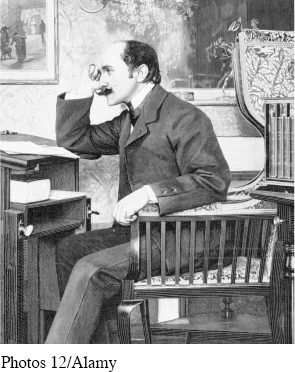9.1 CENTRAL TEXT
Cyrano de Bergerac
Edmond Rostand

Translated by Brian Hooker
Playwright and poet Edmond Rostand (1868–
Since its Paris debut, Cyrano de Bergerac has enjoyed popularity around the globe with stage productions featuring such well-
Cyrano de Bergerac was also made into at least one film during every decade of the twentieth century, beginning in 1900. Notable later film productions include the 1950 version starring José Ferrer, who won the Academy Award for Best Actor; a Japanese samurai film starring Toshiro Mifune titled Aru kengo no shogai (Life of an Expert Swordsman, 1959); an updated comedy called Roxanne starring Steve Martin, who also wrote the screenplay (1987); and a critically acclaimed French production starring Gérard Depardieu (1990).
KEY CONTEXT Although fictitious, the play is loosely based on a real-
While Cyrano de Bergerac was first produced in 1897, it is set in 1640, thus invoking an older romantic milieu and going against the naturalism that dominated French theater at the end of the nineteenth century. This period in French history was one of political and military turmoil and Rostand’s play offered some much-
The plays of this earlier time featured an idealized hero who not only was physically daring and intellectually gifted, but also embodied the code of chivalry. The concept of honor was a cardinal virtue for the classic romantic hero. The chivalric code, which developed within the medieval institution of knighthood between 1170 and 1220, was a system of rules that went beyond combat to include morality and character traits such as courtesy and honor. An integral part of the chivalric code was the idealization of women, who were the source of inspiration. Such a relationship, called courtly love, was almost never consummated but rather inspired respect, devotion, and an almost religious-
The Persons
| CYRANO DE BERGERAC | The Cadets |
| CHRISTIAN DE NEUVILLETTE | Second Marquis |
| COMTE DE GUICHE | Third Marquis |
| RAGUENEAU | Montfleury |
| LE BRET | Bellerose |
| CARBON DE CASTEL- |
Jodelet |
| LIGNIÈRE | A Meddler |
| VICOMTE DE VALVERT | A Musketeer |
| A MARQUIS | Another Musketeer |
| CUIGY | A Spanish Officer |
| BRISSAILLE | A Cavalier |
| ROXANE | The Porter |
| HER DUENNA | A Citizen |
| LISE | His Son |
| THE ORANGE- |
A Cut- |
| MOTHER MARGUÉRITE DE JÉSUS | A Spectator |
| SISTER MARTHE | A Sentry |
| SISTER CLAIRE | Bertrandou the Fifer |
| A Capuchin | The Pages |
| Two Musicians | An Actress |
| The Poets | A Soubrette |
| The Pastrycooks | The Flower- |
The Crowd, Citizens, Marquis, Musketeers, Thieves, Pastrycooks, Poets, Cadets of Gascoyne, Actors, Violins, Pages, Children, Spanish Soldiers, Spectators, Intellectuals, Academicians, Nuns, etc.
(The first four Acts in 1640; the fifth in 1655.)
FIRST ACT A Performance at the Hôtel de Bourgogne.
SECOND ACT The Bakery of the Poets.
THIRD ACT Roxane’s Kiss.
FOURTH ACT The Cadets of Gascoyne.
FIFTH ACT Cyrano’s Gazette.